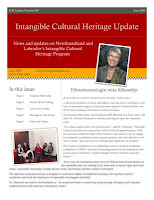
We are working on some updates to the new Memorial Intangible Cultural Heritage website
(http://www.mun.ca/ich/home/) and we've borrowed a vintage hobby horse from Chris Brookes to photograph.
See some of the photos of the said horse on Flickr at:
http://www.flickr.com/photos/dalejarvis/sets/72157619739633905 Heather Patey snapped this photo of the Hobby Horse in the wild (at the NL Folk Festival in Bannerman Park) at:
http://www.flickr.com/photos/hpatey/2376120352/in/pool-969809@N21What is a Hobby Horse, you ask? This from the Dictionary of Newfoundland English:
http://www.heritage.nf.ca/dictionary/hobby horse n also hobby horse and bull. Cp OED ~ 2 'in the morris-dance, and on the stage ... a figure of a horse ... fastened about the waist of one of the performers' (1557-1821); EDD ~ 1: 'a hobby-horse is carried through the streets [of Padstow]' Co. See also HORSY-HOPS. A figure of a horse carried by mummers during Christmas festivities. [1583 (1940) Gilbert's Voyages and Enterprises ii, 396 Besides for solace of our people, and allurement of the Savages, we were provided of Musike in good variety: not omitting the least toyes, as Morris dancers, Hobby horsse, and Maylike conceits to delight the Savage people.] 1893 Christmas Greetings 19 There were hobby horses, men, women, and I don't know what else, with the most outrageous masks and costumes I have ever seen. 1895 PROWSE 402 Each company [of fools or mummers] had one or more hobby-horses, with gaping jaws to snap at people. [1917] 1969 Christmas Mumming in Nfld 175 A weird figure bearing the head of a horse, nodding and gesticulating wildly to his companions ... paraded Water Street ... the oddly garbed figures meanwhile capering in amusing fashion around the hobby-horse—as I found the centre figure was called. M 65-5 In St Philips people sometimes dress up as a hobby-horse, one in front and one in the back. The one in front puts on a horse's head and the one behind has a blanket. The head is carved out of wood and the jaws work on strings. These hobby-horses chase everyone who is not a janny and are considered to be a nuisance. They frighten children and if you let them in the house they would turn the place upside down, turning over chairs, etc. These hobby-horses were ugly creatures and they had horns on their heads to make them look like the devil. When they had horns they were called hobbyhorse-and-bull. T 265-662 Hobby horse they used to call it. There'd be two people stoop down, and they put a big blanket over them, and they'd be walking off like an animal. C 71-116 The jannies make what they call a 'hobby horse.' They have the head of a horse, cow, or moose with a piece of canvas attached to it. About six men get under the canvas. They put nails or something like that in the mouth to make a clacking noise. They put sticks or something in the head so that they can turn it and open and close the mouth. Then this fierce looking thing goes around to the different houses.





